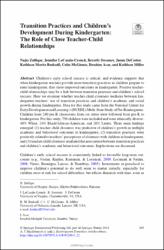Transition practices and children's development during kindergarten: The role of close teacher-child relationships

Göster/
Erişim
info:eu-repo/semantics/embargoedAccessTarih
2018Yazar
Zulfiqar, NajiaLoCasale-Crouch, Jennifer
Sweeney, Baverly D.
DeCoster, Jamie
Rudasill, Kathleen Moritz
McGinnis, Colin
Acar, İbrahim Hakkı
Miller, Kathleen
Üst veri
Tüm öğe kaydını gösterKünye
Zulfiqar, N., LoCasale-Crouch, J., Sweeney, B. D., DeCoster, J., Rudasill, K., McGinnis, C. ... Miller, K. (2018). Transition practices and children's development during kindergarten: The role of close teacher-child relationships. Kindergarten Transition and Readiness: Promoting Cognitive, Social-Emotional, and Self-Regulatory Development içinde (265-281. ss). Springer. https://dx.doi.org/10.1007/978-3-319-90200-5_12Özet
Children's early school success is critical, and evidence suggests that when kindergarten teachers provide more transition practices as children prepare to enter kindergarten, they show improved outcomes in kindergarten. Positive teacher-child relationships may be a link between transition practices and children's school success. Here we examine whether teacher-child closeness mediates between kindergarten teachers' use of transition practices and children's academic and social growth during kindergarten. Data for this study came from the National Center for Early Development and Learning's (NCEDL) Multi-State Study of Pre-Kindergarten. Children from 240 pre-K classrooms from six states were followed from pre-K to kindergarten. For this study, 730 children were included and were ethnically diverse: 40% White, 24% Black/African-American, and 26% Latinx. Three main findings emerged: (1) teacher-child closeness was predictive of children's growth in multiple academic and behavioral outcomes in kindergarten; (2) transition practices were positively related to teachers' perceptions of closeness with children in kindergarten; and (3) teacher-child closeness mediated the association between transition practices and children's academic and behavioral outcomes. Implications are discussed.

















